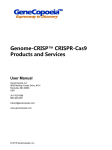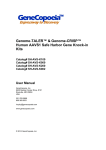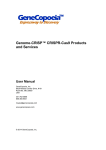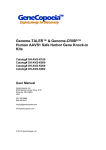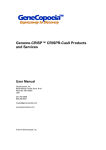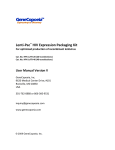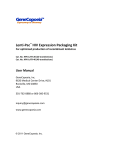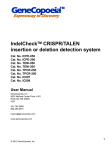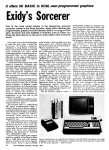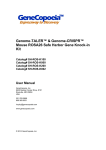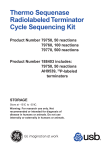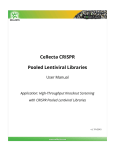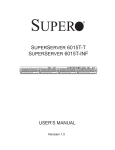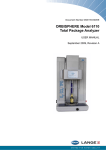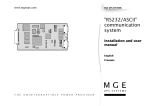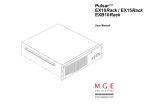Download Genome-CRISP™ human sgRNA Library User Manual
Transcript
Genome-CRISPR™ CRISPR human sgRNA libraries User Manual GeneCopoeia, Inc. 9620 Medical Center Drive, #101 Rockville, MD 20850 USA 301-762-0888 866-360-9531 [email protected] www.genecopoeia.com © 2015 GeneCopoeia, Inc. USER MANUAL Genome-CRISP™ CRISPR human sgRNA libraries Table of Contents I. Introduction .................................................................................................................................3 II. Shipping and Storage ..................................................................................................................5 III. Getting Started.............................................................................................................................7 A. IV. Prepare library for use ....................................................................................................7 1. Bacterial stocks, pooled ....................................................................................7 2. Transfection-ready DNA, pooled .......................................................................8 3. Lentiviral particles, pooled .................................................................................8 B. Analyze sgRNA representation in the library..................................................................8 C. Start with a Cas9-expressing stable cell line ..................................................................9 D. Consider your screening readout .................................................................................10 Protocols ...................................................................................................................................12 A. Transfection of cells with DNA .....................................................................................12 B. Transduction of cells with lentiviral particles ................................................................12 C. Screening .....................................................................................................................14 V. Related products and services ..................................................................................................15 VI. References ................................................................................................................................18 VII. Limited Use License and Warranty............................................................................................19 Genome-CRISP™ CRISPR human sgRNA libraries I. Introduction Loss-of-function screening by gene knockout is a powerful tool for systematic genetic analysis in mammalian cells, facilitating gene discovery, genome-scale functional interrogation (e.g. signal transduction pathways) and drug discovery (e.g. target identification and drug mechanism studies). Recently CRISPR sgRNA libraries have become available for gene knockout studies. In the CRISPR-Cas9 system, a complex of the Cas9 nuclease with a single guide RNA (sgRNA) generates a double-strand break (DSB) in the target DNA, causing frameshiftmutations resulting from nonhomologous end joining (NHEJ). The Genome-CRISP™ human single guide RNA (sgRNA) libraries are cloned into lentiviral vectors for dual-use (transfection or transduction) delivery methods designed for large-scale screens of interested genes. For each targeted gene, a minimum of 2 barcoded sgRNAs targeting different regions are optimized designed, individually cloned, and sequence-verified to ensure efficient gene knockout. Figure 1. Illustration of large scale screening with sgRNA library Advantages • Individually constructed, sequence-verified, individually cultured and pooled sgRNA libraries ensure high quality and good sgRNA representation for selected target gene families. • Premade sgRNA libraries or custom services both available • 2 or more sgRNA clones per target gene • Flexible delivery formats such as pooled lentiviral particles, transfection-ready plasmid DNA, or bacterial stocks Applications • High-throughput knockout screening with many sgRNAs, either individually or in pools. • Drug target discovery Genome-CRISP™ CRISPR human sgRNA libraries The Genome-CRISPTM human sgRNA libraries are constructed as pools of 2 sgRNAs for each gene. At the time of manufacture, each sgRNA-expressing clone is contained in individual bacterial stocks. From there, individual bacterial stocks are pooled, and used either for direct shipment of pooled bacterial stock, isolation of transfection-ready DNA, or further packaging of the DNA into lentiviral particles (Figure 2). Figure 2. Pooling method of Genome-CRISPTM human sgRNA libraries. GeneCopoeia has determined a specific composition of each sgRNA pool (Figure 3). Each gene is represented by 2 sgRNAs: An “ A ” sgRNA and a “ B ” sgRNA. The “ A ” sgRNAs are contained in separate pools from the “B” sgRNAs. Further, each pool carries up to 150 sgRNAs, Pool A Pool B Figure 3. Sub-pooling principle of Genome-CRISPTM human sgRNA libraries. Genome-CRISP™ CRISPR human sgRNA libraries II. Shipping and Storage Pooled bacterial stock: Each tube contains 200 μl of glycerol stock. Catalog# Library name Composition Shipping and Storage L01-LS03-B1 Innate kinases & ubiquitin ligases 4 tubes, 118-119 sgRNAs each Shipped with dry ice. Stored at -80°C L02-LS03-B1 Nuclear hormone receptors 2 tubes, 118 sgRNAs each Shipped with dry ice. Stored at -80°C L03-LS03-B1 Tumor metastasis genes 2 tubes, 57 sgRNAs each Shipped with dry ice. Stored at -80°C L04-LS03-B1 Oncogenes 4 tubes, 144 sgRNAs each Shipped with dry ice. Stored at -80°C L05-LS03-B1 Tumor suppressor genes 4 tubes, 115-116 sgRNAs each Shipped with dry ice. Stored at -80°C L06-LS03-B1 Protein kinases 10 tubes, 131-132 sgRNAs each Shipped with dry ice. Stored at -80°C L07-LS03-B1 Key genes in 50 pathways 2 tubes, 139 sgRNAs each Shipped with dry ice. Stored at -80°C Pooled transfection-ready plasmid DNA: Each tube contains 20-30 mg of transfection-ready plasmid DNA. Catalog# Library name Composition Shipping and Storage L01-LS03-F1 Innate kinases & ubiquitin ligases 4 tubes, 118-119 sgRNAs each Shipped with ice pack. Stored at -20°C L02-LS03-F1 Nuclear hormone receptors 2 tubes, 118 sgRNAs each Shipped with ice pack. Stored at -20°C L03-LS03-F1 Tumor metastasis genes 2 tubes, 57 sgRNAs each Shipped with ice pack. Stored at -20°C L04-LS03-F1 Oncogenes 4 tubes, 144 sgRNAs each Shipped with ice pack. Stored at -20°C L05-LS03-F1 Tumor suppressor genes 4 tubes, 115-116 sgRNAs each Shipped with ice pack. Stored at -20°C L06-LS03-F1 Protein kinases 10 tubes, 131-132 sgRNAs each Shipped with ice pack. Stored at -20°C L07-LS03-F1 Key genes in 50 pathways 2 tubes, 139 sgRNAs each Shipped with ice pack. Stored at -20°C Genome-CRISP™ human sgRNA libraries Pooled lentiviral particles: Each tube contains 2.5 x 106 TU lentiviral particles in 25 μL. Catalog# Library name Composition Shipping and Storage L01-LS03-P1 Innate kinases & ubiquitin ligases 4 tubes, 118-119 sgRNAs each Shipped with dry ice. Stored at -80°C L02-LS03-P1 Nuclear hormone receptors 2 tubes, 118 sgRNAs each Shipped with dry ice. Stored at -80°C L03-LS03-P1 Tumor metastasis genes 2 tubes, 57 sgRNAs each Shipped with dry ice. Stored at -80°C L04-LS03-P1 Oncogenes 4 tubes, 144 sgRNAs each Shipped with dry ice. Stored at -80°C L05-LS03-P1 Tumor suppressor genes 4 tubes, 115-116 sgRNAs each Shipped with dry ice. Stored at -80°C L06-LS03-P1 Protein kinases 10 tubes, 131-132 sgRNAs each Shipped with dry ice. Stored at -80°C L07-LS03-P1 Key genes in 50 pathways 2 tubes, 139 sgRNAs each Shipped with dry ice. Stored at -80°C Additional materials (the following materials may be required but not supplied depending on your experiments) Cat. No. Product Application Clv-PK-01 GeneCopoeia 293Ta Lentiviral packaging cell line For packaging lentiviral particles. HPK-LvTR-20 HPK-LvTR-40 HPK-LvTR-50 HPK-LvTR-100 GeneCopoeia LentiPac HIV Expression Packaging kit For packaging lentiviral particles. CP-LvC9NU-01 CP-LvC9NU-02 Genome-CRISP™ Cas9 nuclease lentiviral expressing clone For Cas9 nuclease packaging lentiviral particles or generating stable cell line with randomly integrated Cas9 nuclease gene. LPP-CP-LvC9NU-01-100 LPP-CP-LvC9NU-02-100 GeneCopoeia pre-made Cas9 lentiviral particles For co-transduction with sgRNA lentiviral particles or generating stable cell line with randomly integrated Cas9 nuclease gene. SCL-01-CA1 SCL-02-CA2 Human stable cell line expressing Cas9 nuclease gene For convenient transfection or transduction of sgRNAs, especially in high-throughout applications Genome-CRISP™ CRISPR human sgRNA libraries III. Getting Started A. Prepare library for use The GeneCopoeia Genome-CRISPTM CRISPR human sgRNA libraries are available as pools in 3 different delivery formats: Bacterial stock, transfection-ready DNA, and lentiviral particles. Follow these guidelines for the preparation of each format for use. 1. Bacterial stocks. For isolation of transfection-ready DNA and/or lentiviral particles. Prepare by using the protocol below. Note: To best maintain even representation of each sgRNA in the library, amplification of library bacterial stocks in liquid culture is not recommended. Instead, library bacteria should be amplified by spreading on LB + ampicillin agar plates, followed by harvesting the bacterial colonies by scraping. One 10 cm plate usually yields at least 30 μ g of plasmid DNA. Miniprep columns can be used for plasmid extraction. If larger yields of plasmid DNA are required, the procedure can be scaled up using larger plates and/or increased numbers of plates. a) For each tube of library bacteria, pre-warm one 10 cm LB plate containing ampicillin inverted at 37℃ for 1-2 hours. b) Fully thaw the library bacterial stocks at room temperature, then place on ice. c) Mix the library bacterial stocks thoroughly by tapping and inverting the tubes several times. Do not vortex. Note: If multiple preparations of plasmid DNA are needed, aliquot the library stocks to multiple tubes to avoid repeated freeze-thaw cycles. Store each aliquot at -80℃. d) Pipette 1 µL of each library stock into 1 mL of liquid LB medium. Mix thoroughly. e) Spread 200 µL of each diluted library stock on each pre-warmed LB + ampicillin plate. Ensure that the bacteria is spread over the plate as evenly as possible. f) Incubate the plates inverted at 37℃ for 16-18 hours. Note: Each plate should contain 0.5-2 x 105 colonies Individual colonies, not a lawn, should be visible. g) Pipette 5 mL of LB medium onto each plate. Scrape the colonies off with a cell spreader or scraper. h) Pipette liquid suspension containing the scraped bacterial cells into a 15mL tube. i) Repeat step g) & h). j) Centrifuge tubes at 4,000 rpm for 10 minutes. k) Proceed with plasmid DNA extraction according to the manufacturer’s instructions for the plasmid preparation kit you are using. Genome-CRISP™ CRISPR human sgRNA libraries 2. Transfection-ready DNA. For packaging into lentiviral particles, use GeneCopoeia’s Lenti-PacTM packaging products (http://www.genecopoeia.com/product/lentiviral-packaging-kit-cells/). Refer to the Lenti-PacTM documentation for packaging instructions. For transfection into your cell line, use GeneCopoeia’s EndofectinTM transfection reagents (http://www.genecopoeia.com/product/endofectin/) 3. Lentiviral particles. The lentiviral particles are ready-to use. For lentiviral transduction protocol, refer to section IV. B. Analyze sgRNA representation in the library. If you are amplifying library bacteria yourself for preparation of DNA, it is important to ensure that the individual sgRNAs are as equally represented in the pools as possible. We recommend analyzing a subset of sgRNAs (approximately 10% of the total number of sgRNAs in the library), which can be PCR amplified using one non-sgRNA-specific primer and one primer specific for each individual sgRNA. You can order these primers for each member of the library from GeneCopoeia. 1. Make a master PCR mix containing: Item Amount per Sample 5 μL ~10 ng 2 μL 0.2 μL 0.25 μL 2.5 μL to 25 μL 25 μL 5X PCR Buffer Purified library plasmid DNA primers(5pmol/μL) 25mM dNTP PCR polymerase (5U/μL) 20mM Mg2+ ddH2O Final 2. Dispense equal volumes of the master mix into individual plate-wells or tubes. 3. Dispense equal volumes of a 5pmol/μL solution of each sgRNA-specific primer (2 μL per sample) inti each well. 4. Mix well by gently pipetting up and down. 5. Seal the plate or tubes and use the following PCR program: 94℃ 5 min 94℃ 30 s 58℃ 30 s 72℃ 30 s 72℃ 5 min 1 cycle 25 cycles 1 cycle C. Start with a Cas9 nuclease-expressing stable cell line. For the best result of all sgRNAs in a in individual cells, it is important to obtain a derivative of your cell line that is stably or ind expressing the Cas9 nuclease gene integrated into the genome, using one of the following approaches: 1. Transduce your cells with Cas9 nuclease lentiviral particles(Figure 4A). Cas9 nucleaseexpressing plasmid DNA (GeneCopoeia catalog numbers CP-LvC9NU-01, CP-LvC9NU-02) can be purchased for do-it-yourself packaging into lentiviral particles using the GeneCopoeia Lenti-PacTM viral packaging system (http://www.genecopoeia.com/product/lentiviral-packaging-kit-cells/). Alternatively, you can purchase pre-made Cas9 lentiviral particles (GeneCopoeia catalog numbers LPP-CPLvC9NU-01-100, LPP-CP-LvC9NU-02-100). Transduction of cells with Cas9-expressing lentiviral particles, followed by G418 selection, leads to stable, random integration of the Cas9-expressing plasmid into the genome. 2. Knock in the Cas9 nuclease gene by using the GeneCopoeia human AAVS1 Safe Harbor Cas9 donor clones (catalog numbers DC-C9NU-04, DC-C9NU-05; figure 4B) and the GeneCopoeia human AAVS1 Safe Harbor knockin kits (http://www.genecopoeia.com/product/aavs1-safe-harbor/). Integration of the Cas9 nuclease gene using CRISPR or TALEN and either DC-C9NU-04 or DC-C9NU-05 occurs specifically at the human AAVS1 locus, and provides consistent, stable expression of Cas9 without deleterious effects on the cells. 3. Order a custom Cas9-expressing stable cell line through GeneCopoeia’s custom stable cell line service. GeneCopoeia will stably integrate Cas9 into virtually any cell line of your choice. For more information on our custom stable cell line services, please visit http://www.genecopoeia.com/product/stable-cell-line/. Genome-CRISP™ CRISPR human sgRNA libraries (A) (B) Figure 4. Cas9 nuclease-expressing plasmids. (A) The Cas9 nuclease lentiviral expression clones CP-LvC9NU-01 (left, w/o fluorescent reporter) & CP-LvC9NU-02 (right, w/ eGFP is used as a fluorescent reporter. (B) Example of Cas9 nuclease expression cassette knockin human AAVS1 locus. D. Consider your screening “readout” When using the Genome-CRISP ™ human sgRNA libraries, it is essential to know how you are going to screen your cells after transfection or transduction. The sgRNAs in each library are designed to knock genes out, via NHEJ-mediated frameshift alleles near the initiator ATG of the mRNA. A readily observable phenotype, or a convenient assay, are needed in order to effectively use the sgRNA libraries for screening. Your screening readout depends on the specific questions you addressing when using the Genome-CRISPTM human sgRNA libraries. A few examples of screening applications include: 1. Drug target discovery. Knockout of a subset of genes in a library could lead to lethality. Performing serial dilutions in order to obtain single clones in 96-well plates would reveal that most wells contain healthy, dividing cells, while other wells would contain either cells with decreased growth rates or no living cells at all. Screening for which sgRNAs are not found among surviving clones suggests drug target discovery candidates. 2. Drug resistance. A particular drug might be lethal to wild type cells. Knockout of a subset of genes could make cells resistant to the drug, and could provide insights into the drug’s mechanism of action, Determination of which genes are modified in surviving cells suggests candidates for targets for that drug. 3. Change in visible cellular phenotype. One example readout of this is growth of cells on soft agar, a classical readout for cancer cell metastasis. Knockout of a subset of genes in non-invasive cells could cause cells to grow on soft agar. Identification of the modified genes in the invasive cells suggests candidate genes important for metastasis under defined experimental conditions. Genome-CRISP™ CRISPR human sgRNA libraries 4. Protein trafficking. Knockout of a subset of genes could cause a change in subcellular localization of a protein carrying an in-frame fusion tag of a fluorescent protein such as GFP. 5. Transcriptional activation. Knockout of a subset of genes could lead to expression of a fluorescent reporter, such as GFP, that is under the control of a promoter sequence. Genome-CRISP™ CRISPR human sgRNA libraries IV. Protocols A. Transfection of Cells With DNA Note: Know the minimum concentration of puromycin needed to kill drug sensitive cells. The Genome-CRISPTM CRISPR human sgRNA library plasmids carry the puromycin resistance gene for stable selection of clones with integrated sgRNA-expressing plasmids (Figure 5). If you don ’t know the minimum concentration of puromycin needed to kill drug sensitive cells, then perform a killing curve using serial dilutions of puromycin. This is important because for lentiviral transduction, puromycin selection is applied shortly after transduction and used for selection of cells with stable plasmid integration. For DNA transfection, we recommend using GeneCopoeia EndofectinTM transfection kits (catalog numbers EFL1001-01, EFL1001-02, EFL1003-01, EFL1003-02). Refer to the kit documentation for detailed DNA transfection protocols. Figure 5. Lentiviral plasmid backbone used for the Genome-CRISPTM CRISPR human sgRNA libraries. Vector backbone contains lentiviral packaging elements. Stable selection is provided by the puromycin resistance gene. mCherry is used as a fluorescent reporter. B. Transduction of Cells With Lentiviruses Before transducing your cell line with sgRNA lentivirus particles, cosider the following: 1. Know the minimum concentration of puromycin needed to kill sensitive cells. See previous section, “B. Transfection of Target Cells With DNA”. 2. Know the optimal MOI for your cell line. If you don’t know this information already, then perform a titration by infecting cells with serial dilutions of lentiviral particles expressing pCRISPR-LvSG03 carrying a scrambled control sgRNA (GeneCopoeia catalog CCPCTR01-LvSG03-B or CCPCTR01-LvSG03-10 for bacterial stock or transfection-ready plasmid DNA, respectively; LPP-CCPCTR01-LvSG03 for pre-made lentiviral particles). Cells with serial dilutions of these lentiviral particles can be visualized for mCherry fluoresence under a microscope. Genome-CRISP™ CRISPR human sgRNA libraries Day 1: Plate cells Plate 2 – 10 x 104 of the target cells per well in a 24-well plate 24 hours prior to viral transduction. Use 0.5 mL of cell specific medium supplemented with 5% heat-inactivated fetal bovine serum, and penicillin-streptomycin (optional) for each well. Incubate the cells at 37°C with 5% CO2 overnight. Note: Make sure the cells reach 70-80% confluence at the time of transduction. Actual cell number to be plated depends on the cell types Day 2: Transduce target cells For each well, prepare 0.5 mL of virus suspension diluted in complete medium with Polybrene at a final concentration of 5–8 µg/mL. Note: Use several dilutions of pseudoviral stock (0.1 μ L to 100 μ L). We recommend gradient dilution of 0.1 μL, 0.3 μL, 3 μL, 10 μL, 30 μL for standard particles, and 0.1 μL, 0.3 μ L, 0.5 μ L, 0.7 μ L, 0.9 μ L for purified particles. Mix the virus with the medium gently by inverting the tubes several times. Do not vortex. 1. Infect the target cells by removing the old culture medium and replacing it with 0.5 ml of diluted viral supernatant. For one well (mock well control), add 0.5 mL of complete medium with Polybrene. Place the plates in a 37°C incubator with 5% CO2 and incubate cells overnight. (Optional: Place the plates for 2 hours at 4-8°C; then transfer the plates to a 37°C incubator with 5% CO2 and incubate cells overnight.) Note: Incubating cells with lentivirus for 2 hours at low temperatures can significantly increase the transduction efficiency. But this step should be omitted if the cells cannot tolerate low temperatures. Day 3: Replace medium/Split cell culture Replace the old medium with 0.5 mL of fresh complete medium (without Polybrene). Alternatively, split the cells 1:5 to 1:25 depending on the cell types by trypsinizing and reseeding the cells onto 6-well plates or 10cm culture dishes. Continue incubating for 48 hours in cell specific medium. Day 5: Analyze transduced cells or start drug selection of stably transduced cells The infected target cells can be analyzed for transient expression of transgenes using an appropriate biological assay. To select stably transduced cells, replace old medium with fresh complete medium containing the appropriate selection drug every 3–4 days until drug-resistant colonies become visible (generally 7–14 days after selection). Genome-CRISP™ CRISPR human sgRNA libraries C. Screening The screening strategy will be influenced by your “readout”, i.e. the phenotype or assay you are using. However, there will be some common elements, as illustrated in figure 6. Cas9 stable cell line Transfect / transduce with sgRNA pools Havest cells in bulk Dilute cells to individual clones Screen for phenotype or assay PCR & sequence sgRNA targets Figure 6. Workflow for Genome-CRISPTM CRISPR human sgRNA library usage and screening. Regardless of the phenotype or assay you are using as your library screening readout, you will need to identify which gene(s) were knocked out to cause a change in that readout. We recommend the following steps: 1. Use the mismatch cleavage assay to analyze the genotype of each gene in the library. The goal of the mismatch cleavage assay is to determine which gene(s) sustained CRISPR-mediated knockout mutations. Use the GeneCopoeia IndelCheckTM CRISPR/TALEN insertion or deletion detection system (catalog numbers ICPE-050, ICPE200, TPCR-050, TPCR-200, TENI-050, and TENI-200). This assay can be performed on either pools of cells or isolated clones. Refer to the IndelCheckTM system documentation for instructions. 2. Genes that are identified by the mismatch cleavage assay are considered candidates that must be verified. To do so, transfect cells with clones or transduce cells with lentiviral particles expressing the individual candidate sgRNA(s). Once you have transfected or transduced your cells with the individual sgRNAs, observe whether or not you are able to reproduce change in phenotype or assay you observed in the initial screen. If you ordered your libraries as pools, then you can purchase the individual sgRNA clones or lentiviral particle stocks directly from GeneCopoeia. Genome-CRISP™ CRISPR 人类 sgRNA 文库 V. Related Products and Services Genome-CRISP™ CRISPR-Cas9 stable cell lines GeneCopoeia offers stable cell lines constitutively expressing the CRISPR Cas9 nuclease. These cell lines provide you with a convenient means to carry out CRISPR genome editing applications with high efficiency, such as high-thoroughput, loss-of-function screening using sgRNA libraries. The Genome-CRISP ™ Cas9 stable cell lines are available pre-made in human and mouse cell lines such as H1299 and HEK293T cells, with the CRISPR Cas9 nuclease stably integrated into the human AAVS1 “ Safe Harbor ” site. In addition, we offer services to stably integrate the CRISPR Cas9 nuclease into your cell line of choice. Figure 7. High thoroughput screening using Cas9 stable cell line and pooled sgRNA libraries. Genome-CRISP™ CRISPR 人类 sgRNA 文库 Human stable cell line expressing Cas9 nuclease gene Cat.No. SCL-01-CA1 SCL-02-CA2 Application Cell line For convenient transfection or transduction of sgRNAs, especially in highthroughout applications Promoter Cas9 integration site Quantity Human H1299 CMV AAVS1 1 tube of 2 x 106 cells Human HEK293T CBh AAVS1 1 tube of 2 x 106 cells Cas9 knockin clones for human AAVS1 safe harbor site Cat.No. Product Application Cas9 AAVS1 knockin donor clone To knock in Cas9 nuclease to human AAVS1 Safe Harbor site using CRISPR or TALEN DC-C9NU-03 DC-C9NU-04 DC-C9NU-05 Selection marker Promoter Cas9 integration site Puro CBh AAVS1 Hygro CBh AAVS1 Neo CBh AAVS1 Human AAVS1 safe harbor gene knockin kits Cat.No. Product Description SH-AVS-K100 Genome-TALER™ human AAVS1 safe harbor gene knock-in kit Includes: AAVS1 TALEN pair (TN-AAVS1) AAVS1 donor cloning vector (DC-DON-SH01) AAVS1 positive control donor (DC-RFP-SH01) knock-in verification primer pairs (HQPAVSHR) SH-AVS-K000 Genome-TALER™ human AAVS1 safe harbor gene knock-in kit (without donor) Includes: AAVS1 TALEN pair (TN-AAVS1) AAVS1 positive control (DC-RFP-SH01) knock-in verification primer pairs(HQPAVSHR) SH-AVS-K200 Genome-CRISP™ human AAVS1 safe harbor gene knock-in kit Includes: AAVS1 All-in-one sgRNA/Cas9 expression clone (HCP-AAVS1-CG02) AAVS1 donor cloning vector (DC-DON-SH01) AAVS1 positive control donor (DC-RFP-SH01) knock-in verification primer pairs (HQPAVSHR) SH-AVS-K002 Genome-CRISP™ human AAVS1 safe harbor gene knock-in kit (without donor) Includes: AAVS1 All-in-one sgRNA/Cas9 expression clone (HCP-AAVS1-CG02) AAVS1 positive control donor (DC-RFP-SH01) knock-in verification primer pairs (HQPAVSHR) Genome-CRISP™ CRISPR human sgRNA libraries Custom CRISPR sgRNA libraries In addition to our pre-made CRISPR sgRNA libraries, GeneCopoeia will, upon request, construct custom sgRNA libraries that cover a set of genes that you choose. To request such custom libraries , contact [email protected]. Custom stable cell line services GeneCopoeia offers the generation of stable cell lines carrying TALEN- or CRISPR-Cas9-mediated site-specific genomic modifications. The services include project consultation, design and generation of TALEN, CRISPR-Cas9 and knockin donor (if needed) constructs, screening and isolation of monoclonal lines of correctly modified cells, as well as generation of master cell banks. Our stable cell line services can also be used with our human and mouse Safe Harbor Integration system. For more information about our genome editing stable cell line services, contact [email protected]. Pre-made Cas9 lentiviral particles Cat.No. Product LPP-CP-LvC9NU-01-100 LPP-CP-LvC9NU-02-100 Promoter Cas9 Nuclease Purified Lentifect™ Lentiviral Particles (100 µl x 1 vial, >1x107 TU/mL ) Reporter gene / Seletion marker CMV Neomycin CMV eGFP/Neomycin Genome-CRISPTM Cas9 nuclease lentiviral expression clones Cat.No. Product Promoter Reporter gene / Selection marker CP-LvC9NU-01 Cas9 nuclease lentiviral expression clone CMV Neomycin CP-LvC9NU-02 Cas9 nuclease lentiviral expression clone CMV eGFP / Neomycin IndelCheck™ CRISPR/TALEN insertion or deletion detection system Cat.No. Product Description ICPE-050 IndelCheck™ CRISPR/TALEN insertion or deletion detection system (50 rxns) Includes target site PCR kit (TPCR-050) and T7 endonuclease I assay kit (TENI-050) ICPE-200 IndelCheck™ CRISPR/TALEN insertion or deletion detection system (200 rxns) Includes target site PCR kit (TPCR-200) and T7 endonuclease I assay kit (TENI-200) TPCR-050 Target site PCR kit, 50 rxns Target site PCR kit, 50 rxns TPCR-200 Target site PCR kit, 200 rxns Target site PCR kit, 20 rxns TENI-050 T7 endonuclease I assay kit, 50 rxns Cleave mismatched PCR products using T7 endonuclease I to detect indel mutations TENI-200 T7 endonuclease I assay kit, 200 rxns Cleave mismatched PCR products using T7 endonuclease I to detect indel mutations Genome-CRISP™ CRISPR human sgRNA libraries VI. References 1. Shalem, et al. (2014). Genome-scale CRISPR-Cas9 knockout screening in human cells. Science 343, 84. 2. Wang, et al. (2014). Genetic screens in human cells using the CRISPR-Cas9 system. Science 343, 80. 3. Zhou, et al. (2014). High-throughput screening of a CRISPR/Cas9 library for functional genomics in human cells. Nature 509, 487. 17 Genome-CRISP™ CRISPR human sgRNA libraries VII. Limited Use License and Warranty Limited Use License The following terms and conditions apply to use of the Genome-CRISPRTM human sgRNA libraries (the Product). If the terms and conditions are not acceptable, the Product in its entirety must be returned to GeneCopoeia within 5 calendar days. A limited End-User license is granted to the purchaser of the Product. The Product shall be used by the purchaser for internal research purposes only. The Product is expressly not designed, intended, or warranted for use in humans or for therapeutic or diagnostic use. The Product must not be resold, repackaged or modified for resale, or used to manufacture commercial products or deliver information obtained in service without prior written consent from GeneCopoeia. This Product should be used in accordance with the NIH guidelines developed for recombinant DNA and genetic research. Use of any part of the Product constitutes acceptance of the above terms. Limited Warranty GeneCopoeia warrants that the Product meets the specifications described in the accompanying Product Datasheet. If it is proven to the satisfaction of GeneCopoeia that the Product fails to meet these specifications, GeneCopoeia will replace the Product. In the event a replacement cannot be provided, GeneCopoeia will provide the purchaser with a refund. This limited warranty shall not extend to anyone other than the original purchaser of the Product. Notice of nonconforming products must be made to GeneCopoeia within 30 days of receipt of the Product. GeneCopoeia’s liability is expressly limited to replacement of Product or a refund limited to the actual purchase price. GeneCopoeia’s liability does not extend to any damages arising from use or improper use of the Product, or losses associated with the use of additional materials or reagents. This limited warranty is the sole and exclusive warranty. GeneCopoeia does not provide any other warranties of any kind, expressed or implied, including the merchantability or fitness of the Product for a particular purpose. GeneCopoeia is committed to providing our customers with high-quality products. If you should have any questions or concerns about any GeneCopoeia products, please contact us at 301-7620888. © 2015 GeneCopoeia, Inc. For Research Use Only. Trademark: Genome-CRISPTM, GeneCopoeiaTM (GeneCopoeia, Inc.) © 2015 GeneCopoeia, Inc. CL-030315 21



















